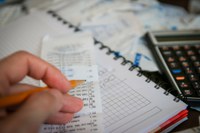Income Tax Filing Deadline is March 1 for Agricultural Producers
(Click the image below to view a high-resolution image that can be downloaded)
[Editors: This story will not be valid after March 1.]
Agricultural producers have until March 1 to file their 2020 income tax returns without penalty if they have not made estimates.
“Producers have until April 15 to file without penalty if they have paid their estimated tax by Jan. 15,” says Ron Haugen, North Dakota State University Extension farm economist.
“It is important to note changes in tax regulations due to the CARES Act and other legislation due to the COVID-19 pandemic,” he adds.
Items to note for 2020 income tax preparation:
- Coronavirus Food Assistance Program (CFAP) payments are agricultural program payments that you must include in gross income. Report the full amount of your CFAP payments on Schedule F (Form 1040).
- The current rule is that you can deduct expenses that are allocable to a Paycheck Protection Program (PPP) loan you received that’s later forgiven.
- The CARES Act revised the provisions related to net operating loss (NOL) carrybacks to allow taxpayers to carryback NOLs, including nonfarm NOLs arising from tax years 2018, 2019 and 2020, for five years.
- Schedule SE has changed to allow self-employment tax payments that may have been deferred.
- The standard deduction is $24,800 for those who are married and filing jointly and $12,400 for singles.
- The Social Security wage base for 2020 is $137,700.
- The standard mileage rate for 2020 is 57.5 cents per mile.
- Agricultural producers are allowed to use 200% declining balance depreciation for three-year, five-year, seven-year and 10-year property. The 150% declining balance method still is required for 15- and 20-year property.
- For most new agricultural machinery and equipment (except grain bins), the recovery period is five years.
- Like-kind exchanges are not allowed for personal property but are allowed for real property.
- The section 179 expense allows producers to deduct up to $1,040,000 on new or used machinery or equipment purchased in the tax year. There is a dollar-for-dollar phase-out for purchases above $2,590,000.
- The additional 100% first-year bonus depreciation is in effect. It is available for used and new property. It is equal to 100% of the adjusted basis after any section 179 expensing.
- Income averaging can be used by producers to spread the tax liability to lower income tax brackets in the three previous years. This is done on schedule J. North Dakota farmers who elect to use income averaging for federal purposes also may use Form ND-1FA, which is income averaging for North Dakota income tax calculations.
- Crop insurance proceeds and government crop disaster payments can be deferred to the next tax year if a producer is a cash-basis taxpayer and can show that normally income from damaged crops would be included in a tax year following the year of the damage.
- A livestock income deferral is available for those who had a forced sale of livestock because of a weather-related disaster.
Information on agricultural tax topics can be found in the “Farmers Tax Guide,” publication 225. It is available at any IRS office or can be ordered by calling 800-829-3676. Any questions about these topics or further updates should be addressed to your tax professional or the IRS at 800-829-1040 or https://www.irs.gov. Call the North Dakota Tax Department at 877-328-7088 or go to http://www.nd.gov/tax for answers to North Dakota income tax questions.
NDSU Agriculture Communication - Jan. 29, 2021
Source: Ron Haugen, 701-231-8103, ronald.haugen@ndsu.edu
Editor: Ellen Crawford, 701-231-5391, ellen.crawford@ndsu.edu


